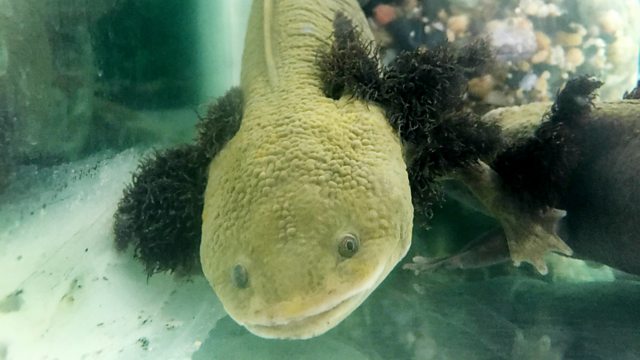The Sisters of the Sacred Salamander
Can a convent of nuns in Mexico save a species of great scientific interest and a Mexican cultural icon? Victoria Gill meets the unconventional breeders of the amazing axolotl.
A convent of Mexican nuns is helping to save the one of the world's most endangered and most remarkable amphibians: the axolotl, a truly bizarre creature of serious scientific interest worldwide and an animal of deep-rooted cultural significance in Mexico.
The Sisters of Immaculate Health rarely venture out of their monastery in the central Mexican town of Patzcuaro. Yet they have become the most adept and successful breeders of their local species of this aquatic salamander. Scientists marvel at their axolotl-breeding talents and are now working with them to save the animal from extinction. 大象传媒 News science correspondent Victoria Gill is allowed into the convent to discover at least some of the nun's secrets and explores why axolotls are a group of salamanders so important to protect from evolutionary oblivion.
Axolotls are able to regrow lost limbs and other body parts. As a result, the aquatic salamanders are of great interest to researchers worldwide who study them in the hope of imitating the trick: to grow tissues and organs for medicine. The nuns also began to breed and rear their axolotls for medical reasons. They use the salamander as the key ingredient in an ancient Mexican remedy for coughs and other respiratory illnesses. The Sisters of Immaculate Health sell the medicinal syrup to the public. As well as being the basis for a popular folk remedy all over Mexico, the axolotl is also the manifestation of one of the ancient Aztecs' most important gods.
The big problem is that all species of axolotl are critically endangered. The nun's species is known locally as the achoque. It only lives in nearby Lake Patzcuaro and it has been pushed to the edge of extinction because of pollution and introduced fish species. This is why the sisters began to breed the animals in the convent about 30 years ago. They were advised to do this by a friar who was also a trained biologist because the supply of achoques from Lake Patzcuaro's fishermen diminished. In the 1980s, 20 tonnes of axolotls were fished from the lake every year. Today they are very few left in the wild.
Biologists from the nearby Michoacan University discovered that the nuns are expert breeders of the species and have started to collaborate with them in a conservation programme to make the Lake Patzcuaro an axolotl-friendly habitat once more and (if necessary) to introduce convent-bred animals to restore the lake's tiny population. The project is being supported and funded by the UK's Chester Zoo. The zoo's curator of amphibians Dr Gerardo Garcia visits the convent with Victoria, and demonstrates some of the technical help being offered to the nuns. For example, he micro-chips and takes DNA samples from the nun's breeding salamanders so the sisters can refine their breeding success even further.
Producer: Andrew Luck-Baker.
Featured in...
![]()
Seriously...—Seriously...
A rich selection of documentaries aimed at relentlessly curious minds.
Nazanin and the mystery of a decades old tank debt
Seriously... Archive
Even more seriously interesting documentaries from Radio 4.
Seriously... Reads
Read more about some of the amazing stories in Seriously...
Podcast
-
![]()
Seriously...
Seriously is home to the world鈥檚 best audio documentaries. Introduced by Vanessa Kisuule.




